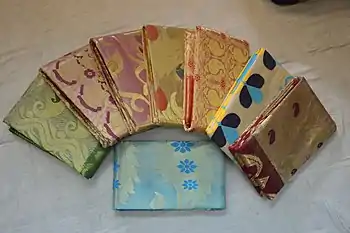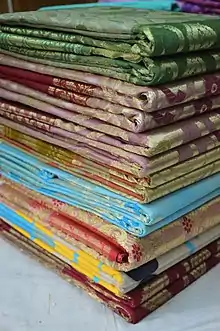Tussar silk
Tussar silk (alternatively spelled as tussah, tushar, tassar,[1] tussore, tasar, tussur, tusser and also known as (Sanskrit) kosa silk) is produced from larvae of several species of silkworms belonging to the moth genus Antheraea, including A. assamensis, A. mylitta, A. paphia, A. pernyi, A. roylei and A. yamamai. These silkworms live in the wild forests in trees belonging to Terminalia species and Shorea robusta as well as other food plants like jamun and oak found in South Asia, eating the leaves of the trees they live on.[2][3] Tussar silk is valued for its rich texture and natural deep gold colour, and varieties are produced in many countries, including China,[4] India, Japan, and Sri Lanka.[5]

Process
In order to kill the silkworms, the cocoons are dried in the sun. A variation of the process exists in which the silkworms are allowed to leave before the cocoons are soaked in boiling water to soften the silk and then reeled.[2][3] Single-shelled, oval-shaped cocoons are collected and then boiled to extract the silk yarn. Boiling is a very important part in the manufacturing of silk, as it softens the cocoon and makes the extraction of silk easier. In conventional sericulture, the cocoons are boiled with the larvae still inside; however, if the cocoons are boiled after the larvae have left them, the silk made is then called "non-violent silk" or "Ahimsa silk". In China, the silks are given different names when silkworms are reared on different plants, as the diet of the silkworms has an effect on the quality of the silk. For example, silk from larvae on the wild mulberry is called zhe, while those on the oak Quercus dentata produce hu.[4]
Tussar silk is considered more textured than cultivated Bombyx or "mulberry" silk, but it has shorter fibres, which makes it less durable. It has a dull gold sheen.[2][3] As most of the cocoons are collected from the forest, it is considered by many as a forest product.
Production in India

India is the second largest producer of tussar silk and the exclusive producer of Indian tussar (also known as tropical tussar), which is largely tended to by tribals. Much of it is produced in Bhagalpur (where it is called Bhagalpur silk), Bihar and Malda district of West Bengal. Tussar silk is also used for Orissa's pattachitras and West Bengal's kantha stitches. Chhattisgarh and Madhya Pradesh also produce tussar silk.[2][3] In recent years, the state of Jharkhand has emerged as the biggest producer of tussar silk.[6]
Uses
The saree is the most important tussar silk product[8][9] although it is also used as the base material for handicrafts, furnishing fabrics, and stitched apparel.[2]
With the introduction of chemical dyes, the range of available colors has increased significantly.[2] There are fashion designers who use tussar silk in their creations. The precisely finished and designer garments produced from tussar silk are known globally and are exported worldwide.
Tussar silk is a popular additive to soap. The short silk fibers are typically dissolved in lye water, which is then added to oils to make soap. Soap made with Tussar silk has a "slippery" quality and is considered more luxurious-feeling than soap made without. Tussar silk roving can be bought at soapmaking supply stores. [10]
References
| Wikimedia Commons has media related to Tussar silk. |
- Pandey, Dr.S.N. (1 September 2010). West Bengal General Knowledge Digest. Upkar Prakashan. p. 28. ISBN 9788174822826. Archived from the original on 31 January 2016. Retrieved 26 January 2016.
- "Tussar Silk". Copper wiki. Archived from the original on 11 March 2012. Retrieved 7 May 2012.
- "Learning Centre". Brass Tacks, Madras. Archived from the original on 29 April 2012. Retrieved 7 May 2012.
- Su Jing, Lun Luo, Landlord and Labor in Late Imperial China: Case Studies from Shandong, Harvard University Asia Center, 1978 ISBN 0-674-50866-1
- Eliza Thompson, Silk, Read Books, 2010 ISBN 1-4086-9508-1
- "Silk Exhibition: देशके विभिन्न राज्यों की प्रसिद्ध सिल्क साड़ियों का किया गया है डिस्पले". Dainik Bhaskar. 27 August 2016. Archived from the original on 29 May 2018. Retrieved 22 November 2016.
- "Bhagalpur Silk Handloom Cluster". Asian Society for Entrepreneurship Education & Development. Archived from the original on 23 April 2012. Retrieved 7 May 2012.
- "Alluring designs in silk". Chennai, India: The Hindu, 2 August 2009. 2 August 2009. Archived from the original on 7 November 2012. Retrieved 7 May 2012.
- "It's worth to be at Weaves". Chennai, India: The Hindu, 11 October 2009. 11 October 2009. Archived from the original on 29 August 2012. Retrieved 7 May 2012.
- "Brambleberry Store". Brambleberry. Retrieved 27 December 2019.